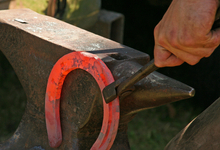According to reports, a farrier at the University of Pennsylvania School of Veterinary Medicine is using a new technique to prevent lameness in horses.
Using a force-sensing film attached to a small electronic recording device that measures the stresses on the horse's foot as it walks, Farrier Patrick T. Reilly uses that information as he works toward making better shoes to treat various forms of lameness in much the same way as a podiatrist assesses and develops orthotics for humans.

Better horse shoes to prevent lameness
Farrier Patrick T. Reilly works toward making better shoes for horses to treat various forms of lameness in much the same way as a podiatrist assesses and develops orthotics for humans.
Reilly is a farrier who shoes horses and helps manage the health of their limbs and feet. He runs a research lab and teaches at the University of Pennsylvania School of Veterinary Medicine, where he hopes the new force-sensing film will help him in a big quest.
Reilly's prime target is laminitis, a poorly understood, crippling disease that has plagued horses for centuries. The illness involves painful inflammation and, in severe cases, separation of the hoof from the foot. After colic, it is the second most common reason that horses are euthanized, as happened with its most famous victim, Barbaro.
Working at the New Bolton Center, Reilly is seeking to improve his trade both through modern technology and by studying old horseshoes from the 19th century, in hope of rediscovering expertise from the days when the horse was a primary engine of the U.S. economy.
Penn's vet school is one of the few with a farrier on staff, allowing Reilly to provide a bridge between science and the barn, said Jeffrey Thomason, a professor at the Ontario Veterinary College at the University of Guelph in Canada.
Reilly's aim is to make a shoe to better ease pressure on the hooves of a lame horse, allowing it to recover.
Farriers have been trying new shoes for centuries, but it is hard to tell if you are alleviating something unless you can measure it. So several years ago, Reilly decided to start doing just that.
Using a system made by Tekscan Inc. of Boston, which tracks force by measuring electrical resistance Reilly can measure horses on the move on a variety of surfaces, and take readings of the pressure on various points of the horse's hoof.
Traditionally, farriers and vets have gauged the effects of their treatments by watching to see if the horse limped. High-tech diagnostic tools, such as ultrasound and magnetic resonance imaging, are now also used.
Some argue that horses are better off with no shoes at all, echoing the barefoot-running movement in people. Thomason, who studies horse biomechanics at Guelph, said that the practice works in some cases, but that if the horse is carrying a lot of weight, the hoof typically needs protection.
Shoe or no shoe, horses get laminitis, and usually the initial cause has nothing to do with the foot, said veterinarian Hannah Galantino-Homer, a Penn colleague of Reilly's.
The disease can be triggered by infections elsewhere in the body, such as the intestines, lungs, or uterus. This sets off an inflammatory cascade, causing the release of enzymes that can break down the sensitive tissue that connects hoof to foot.
Other causes include eating too much grass, which can lead to insulin resistance, she said. Laminitis can also be caused by severe overwork, but this is much less common, said Thomason, the biomechanics researcher.
Though the cause may not start with the foot, Reilly hopes he can solve the problem from that end. Unlike Barbaro, horses do sometimes recover from laminitis. If Reilly can redistribute the pressure on their hooves, he can buy them time to heal.
